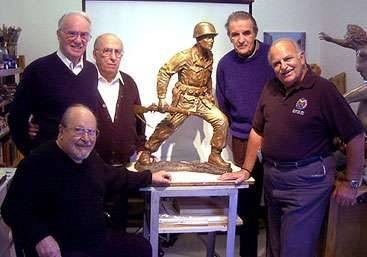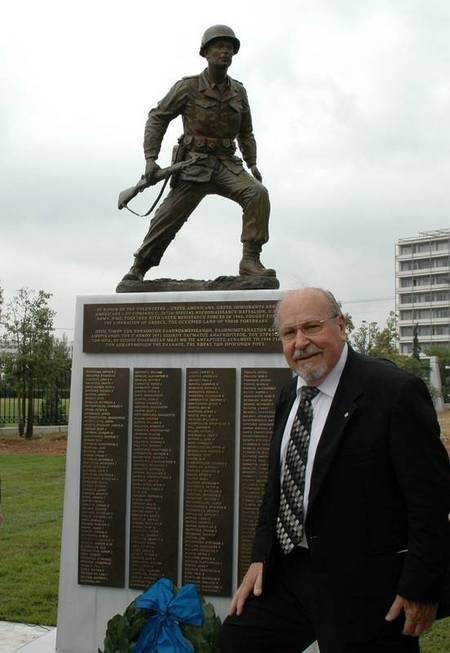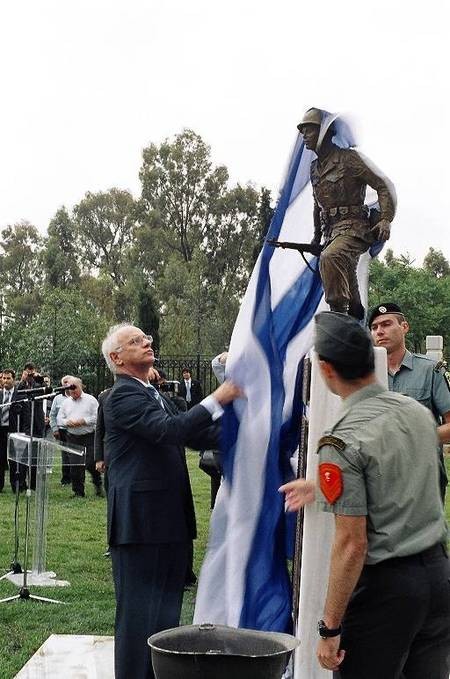Greek Operational Group Soldier Monument

January 2003:
The sculptor and four of the surviving members of the Greek-American Operational Group, in the sculptor's studio.
L to R: Sculptor Andrew G. Saffas (seated), Andrew S. Mousalimas, Alex P. Phillips, Nicholas H. Cominos, and Angelo N. Lygizos
My friend Andy Saffas, a very great artist, who is married to a Kytherian lady Nikie Andronicos, has sent me pictures of the latest sculpture that he has completed. Dedicated to the Greek American OSS volunteers of WW II.
COMPANY C 2671st SPECIAL RECONNAISSANCE BATTALION
aka Greek/US Operational Group
The genesis of Co. C 2671 Special Reconnaissance Battalion was the 122nd Infantry Battalion (aka the Greek Battalion). Founded by an executive order of President Franklin D. Roosevelt, the battalion was designated the 122nd to commemorate 122 years of Greek independence following 400 years of Ottoman rule.
By August 1943, the 122nd had completed seven grueling months of infantry training at Camp Carson Colorado, under the superb leadership of Major Peter D. Clainos, the first Greek-born West Point graduate. OSS officers advised the battalion that they were seeking volunteers for a covert, hazardous mission, and that the casualty rate was expected to be very high. According to Major Clainos all of the battalion volunteered. Initially the OSS officers asked for 15 volunteers, but after the battalion was reviewed they revised the number to 200
The 200 volunteers were sent to Maryland for commando training; because his rank was too high to command a small unit, Major Clainos was transferred. Lieutenant Robert F. Houlihan of Lexington KY was appointed the Commanding Officer of the Greek Operational Group. The Greek Battalion was disbanded, and the men were assigned to other Infantry Units.
In 1944, the Greek/US Operational Group infiltrated Greece by boat or parachute, and joined forces with Greek Resistance fighters (Antartes). With support from British forces and the Antartes, the OSS commandos disrupted the German withdrawal from Greece by destroying bridges, convoys, trucks, trains and railroad tracks, which aided the Allies. The war record of the Greek/USOG is one the best kept secrets of WW II; the records of all the Ethnic Operational Groups were kept sealed by the CIA until 1988.
Continuing a Hellenic tradition of courage, the valiant members of the Greek/US Operational Group contributed to the WW II Allied victory in Europe and to the liberation of Greece

Hellenic Minister of National Defense, Spilios P. Spiliotopoulos,unveiling the Monument.
Additional info;
The Greek / American Operational Groups' Valor Cited
as Statue is Unveiled in Athens, Greece
Report of the Events
May 2005
Company C 2671 Special Reconnaissance Battalion also known as Greek / American United States Operational Group (Greek/USOG), an elite unit of commandos who fought in Greece during WWII, were honored 26 May 2005, in a ceremony held by the Greek Ministry of Defense at the Armed Forces Park in Athens, Greece.
Members of the Greek/USOG family who attended the festivities were veterans Nicholas H. Cominos and his wife Joan, Angelo Lygizos, Andrew S. Mousalimas and his wife Mary; widows and relatives of the veterans: Mrs. James Andros, Mrs. George Portolas, Mrs Vasili Portolas, Mrs James Thomas and son Sammi; Cris Georgalos (sister of Tom P. Georgalos), Katerina Tsouras (niece of James Frangias), and Kostas Katsilanis (nephew of Lambros Makris).
The statue depicting an American soldier of a Greek/USOG was unveiled by the Greek Minister of Defense, Mr. Spilios Spiliotopoulos, in the presence of representatives of all the Armed Forces of Greece, six representatives of the American Embassy including four military attaches, and guests.
Mr. Spiliotopoulos, presented to the Greek/USOG veterans a Greek military medal and affirmed:
American volunteers had fought together with Greek resistance forces for the liberation of Greece. The actions of the Greek American Volunteers express in general their contribution in all our nation's struggles and exemplifies the attachment to modern Greece with the ancient values and ideals of our Hellenism. We consider our Hellenes abroad as one of the most important contributors to our nation's strength. In all difficult occasions, they continually contribute valuable services to our nation.
Constantine Korkas, Lieutenant General (ret) delivered a brief history of the Greek/USOG. Copies of a documented history edited by General Korkas and published in Greek by the Department of Military History, were given to everyone in the gathering. Titled The Greek-American Volunteers in the [Greek] National Resistance, the book is a collection of official documents, detailed accounts, translated into Greek from the files of the National Archives of the United States. The book also contains photographs and maps of the operations by the Greek/USOG as well as a preface by Lieutenant General Korkas (ret.) and an introduction by Major General Ioannis Kakoudakis. Twenty thousand copies have been printed for distribution. [note]
General Korkas then presented a bronze medallion, a replica of the soldier statue, to the widows and relatives of the deceased veterans. He emphasized the monument has been the catalyst for the recognition of the American soldiers who fought in Greece in WWII.

Andy Saffas standing in front of the monument and his sculpture in Athens.
Following the unveiling of the monument and the ceremonies, the Greek Military hosted a buffet for all the attendees.
The evening of 26 May, 2005, veterans, wives, widows, family members, and invited guests were received by the curators of the Military Museum in Athens. The military museum contains artifacts and histories from the battle at Marathon and the many battles of Alexander the Great to modern events. Plans are in progress to add the history of the Greek/USOG into the museum. (Updates about developments will be posted in the OSS web site.) These plans are the work of General Korkas; he has also produced and narrated a film of the history of the Greek/USOG which is in the Greek Military museum.
27 May, 2005, the veterans, widows and families were guests at the Special Forces Training Center for their graduates' oath-taking ceremony. The Special Forces Camp is located at the Saronikos Gulf where, in 480 BC, Themistocles destroyed the Persian Fleet at the great naval battle of Salamis. It is compulsory for every Greek young man to serve two years in the Armed Forces. The Special Forces, an elite army unit, were impressive. After the ceremony the Commanding General of the Special Forces hosted his guests to lunch.
Six groups of the Greek/USOG and one group of the Yugoslavian/USOGinfiltrated Greece in 1944, landing either amphibiously or by parachute, joining forces with the Greek resistance. The groups operated in various regions of northern Greece from May to November, 1944, disrupting the withdrawal of Axis forces. Co. C was awarded the Presidential Unit Citation for their outstanding battle record in Greece.
The genesis of the Greek/USOG is the 122nd Infantry Battalion, also known as The Greek Battalion, at Camp Carson, Colorado. The battalion was founded in January 1943 by a special executive order of President Franklin D. Roosevelt. June, 1943. President Roosevelt and Chief of Staff General George Marshall made a historic visit to Camp Carson to review the Greek Battalion.
A reunion of the Greek/USOG veterans convened in Athens in 1994. General Korkas in 1995 contacted Andrew Mousalimas and requested information, artifacts, photos, memorabilia and newsletters of the Greek/USOG and began diligently to gather evidence about the American volunteers who fought on Greek soil in WWII.
1998, a Soldier Committee was organized in Oakland, California and appointed Mrs. Sophia Johnston as the chairperson. The purpose of the committee was to promote the monument, assure its accuracy, to raise the necessary funding for the statue. Veterans Nick H. Cominos, Alex P. Phillips (since deceased), and Andrew S. Mousalimas were invited to join the committee as eyewitness historians.
The Soldier Memorial Monument is a 1-meter bronze statue sculpted by the California artist, Mr. Andrew G. Saffas. To be sure the soldier statue would be accurate in all respects, Mr. Saffas spent hundreds of hours researching, consulting with military experts and USOG veterans, and procuring authentic uniform, gear and weapons.
The statue is positioned on a 2-meter marble base. A plaque is attached to the front of the base, listing the names of the volunteers. Another plaque is attached to the back of the base, listing the names of the donors.
Over the next few years, Andrew Saffas sent photos of the statue's work-in-progress to General Korkas and communicated with him by telephone. Mr. Saffas furthermore traveled numerous times to Greece with his wife, Niki, and Mrs Johnston to meet with General Korkas and inspect the possible sites for the monument.
Meanwhile Nick H. Cominos and Andrew S. Mousalimas, who were based on the island of Vis in the Adriatic in WWII, and were familiar with the Yugoslavian/USOG discovered significant details about this unit in the National Archives. They uncovered the names of thirty-two men of this unit who had entered Greece in 1944, as Group VII of the Greek/USOG. Twenty-eight of these men were Greek / Americans. Cominos and Mousalimas agreed the veterans of the Yugoslavian/USOG must be included on the plaque.
Andrew Saffas had finalized the plans for the plaque and was initially concerned that the additional names would alter the aesthetics of the monument, but agreed with Cominos and Mousalimas that it would be morally wrong to omit the names of the Yugoslavian/USOG and made the necessary adjustments to the plaque.
28 May, 2005, General Korkas hosted a dinner for the three veterans and their wives. We thanked him and told him we are deeply indebted to him. Without his diligence and determination the unveiling of the monument in Greece might never have taken place. He was sorry more veterans were not able to attend. The attrition rate of our veterans has taken a major toll in the past decade; the few veterans who are still alive and were interested in attending the festivities were not physically able to travel.
Nick Cominos, Angelo Lygizos, Andrew Mousalimas and Andrew Saffas refered to General Constantine Korkas as the Godfather of the veterans of the Greek/USOG.
We are particularly grateful to the Greek Military, who were terrific hosts and more importantly endorsed the placement of the monument of the Greek/USOG in the Armed Forces Park.
Very special thanks to Andrew Saffas and his wife Niki Saffas, and to Sophia Johnston and her committee.
Without these dedicated people the Greek/USOG and Yugoslavian/USOG might not have been recognized in Greece.
The history and valor of the USOG of WWII is one of the best kept secrets in America. The records were classified in the National Archives until 1988. As a result, the Greek people, with rare exception, did not know American soldiers had fought on Greek soil for the liberation of Greece. Recognition of the unit in Greece was of the utmost importance to the Greek/USOG veterans.
Andrew S. Mousalimas
Veteran, Co. C. 2671 Special Reconnaissance Battalion.
The one meter bronze statue for the Monument was completed by Andrew G. Saffas in January 2003.
Andrew’s friendship – of more than 50 years – with some of the Greek/USOG survivors was the source of inspiration for creating a soldier for the monument. In December 1998, he began to create designs for the proposed monument. In 1999, driven by the desire to honor these men, he produced countless drawings to achieve a design that would do them justice. He created a design depicting a GUSOG soldier, alert, determined, and ready for combat. At the age of 77, realizing that he might have just a few productive years remaining, he made the decision to create a clay prototype for the bronze soldier. Thereafter, to ensure that the Soldier would be accurate in all respects, Andrew spent hundreds of hours researching, consulting with military experts, and procuring authentic uniform, gear and weapons.
Enthused by the project, WWII collectors Greg Kareofelas and Randy Canova – of Davis and Carmichael, CA – lent Andrew, for reference, authentic items which were used by the U.S. Army in 1943. These included canteen, helmet, jacket, paratrooper boots, .45 automatic, and M-1 rifle. Andrew was meticulous throughout the process of making the Soldier, from building the armature to the finished product.
A measure of Andrew’s talent is his prowess in building an armature using materials like metal rods, balsa wood, styrofoam, paper, tape, and wire which will properly reflect the motion he desires in his sculpture. When he is satisfied with the armature, he then applies clay to it, following the muscular contours of the human body. Andrew uses a plastiline clay which does not harden and permits him to work intermittently.
Even though the Soldier eventually would be in full battle dress, Andrew first shaped it in general anatomical form. Observing a live model, he then proceeded to add layers of clay to the armature, detailing the shapes and folds of the clothing with his hands and sculpting tools. Gear and weapons were among the last items he modeled and attached. His final concentration was on the features and expression of the face.
In late August 2002, Andy delivered the prototype to the Artworks Foundry & Gallery in Berkeley, CA to undergo the mold-making process. It was a complicated piece which required many sections to be cast separately (using the classic lost wax process), before being assembled and welded together. At the top of this page are photos of the finished Soldier.